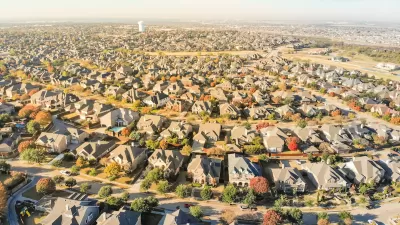A new report from the Harvard Joint Center for Housing Studies released this week claims that sprawl is poised to make a comeback after a pause driven by the recession, and not lasting changes in lifestyle choice, reports Robbie Whelan.
We've already seen the stirrings of the moribund housing market's revival causing an increase in home sizes. So perhaps it shouldn't be a surprise that, rejecting optimism about a new normal of shrinking home sizes, the crux of the annual "State of the Nation's Housing" [PDF] report states that, "The current pause in exurban housing development has more to do with cooling demand caused by the downturn than with a major change in lifestyle choices."
"What drives people to buy those homes is a combination of price and the type of house they're looking for," says Chris Herbert, the center's director of research. "This is not a fundamental shift in trends. It's more a reflection of how the recession has shifted people's behavior."
People that are now "frozen in place" by the effects of the recession, "will likely continue to move to where the space is: the suburbs, and even more so, the exurbs," once the market returns to "normal" strength, says the report.
"How much new housing will we need when household growth gets back to normal and vacancies start to clear? About 1.6 million units a year," Mr. Herbert says. "That's a lot of housing to squeeze into the existing urban and suburban infrastructure."
FULL STORY: What’s Next For Housing? More Sprawl

Maui's Vacation Rental Debate Turns Ugly
Verbal attacks, misinformation campaigns and fistfights plague a high-stakes debate to convert thousands of vacation rentals into long-term housing.

Planetizen Federal Action Tracker
A weekly monitor of how Trump’s orders and actions are impacting planners and planning in America.

Chicago’s Ghost Rails
Just beneath the surface of the modern city lie the remnants of its expansive early 20th-century streetcar system.

Bend, Oregon Zoning Reforms Prioritize Small-Scale Housing
The city altered its zoning code to allow multi-family housing and eliminated parking mandates citywide.

Amtrak Cutting Jobs, Funding to High-Speed Rail
The agency plans to cut 10 percent of its workforce and has confirmed it will not fund new high-speed rail projects.

LA Denies Basic Services to Unhoused Residents
The city has repeatedly failed to respond to requests for trash pickup at encampment sites, and eliminated a program that provided mobile showers and toilets.
Urban Design for Planners 1: Software Tools
This six-course series explores essential urban design concepts using open source software and equips planners with the tools they need to participate fully in the urban design process.
Planning for Universal Design
Learn the tools for implementing Universal Design in planning regulations.
planning NEXT
Appalachian Highlands Housing Partners
Mpact (founded as Rail~Volution)
City of Camden Redevelopment Agency
City of Astoria
City of Portland
City of Laramie





























